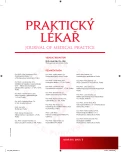The evaluation of assessment tools for needs identification in family members in palliative care
Authors:
R. Bužgová; L. Sikorová; R. Kozáková; D. Jarošová
Authors‘ workplace:
Vedoucí: doc. PhDr. Darja Jarošová, Ph. D.
; Děkan: doc. MUDr. Jaroslav Horáček, CSc.
; Ústav ošetřovatelství a porodní asistence
; Lékařská fakulta Ostravské univerzity v Ostravě
Published in:
Prakt. Lék. 2013; 93(3): 105-109
Category:
Of different specialties
Overview
A needs assessment of family members is an important part of palliative care. Standardized assessment tools for a needs assessment, which are used abroad both for research and clinical practice, may help doctors and health professionals facilitate communication with families. The aim of this review is to analyze assessment tools for a needs assessment of family members in palliative care and to compare their applicability to research and clinical practice. In electronic databases (Medline, Scopus, Proquest Public Health and Web of Knowledge) 11 assessment tools were found and analyzed in detail. The questionnaires aimed at a needs assessment usually include the following domains: needs related to a patient´s comfort, quality of life, need for information, practical needs, quality of care provided and emotional support. On the basis of an assessment tools analysis, the Family Inventory of Needs (FIN) and Need Satisfaction Scale (NSS) questionnaires were found to be applicable in terms of the domains of needs and an adequate number of items.
Keywords:
assessment tools – palliative care – needs – family member
Sources
1. Aoun S, Bird S, Kristjanson LJ, Corrow D. Reliability testing of the FAMCARE-2 scale: measuring family carer satisfaction with palliative care. Palliat Med 2010; 24(7): 674–681.
2. Dawson NJ. Need satisfaction in terminal care settings. Soc Sci Med 1991; 32(1): 83–87.
3. Deeken JF, Taylor KL, Mangan P, et al. Care for the caregivers: a review of self-report instruments developed to measure the burden, needs, and quality of life of informal caregivers. J Pain Symptom Manage 2003; 26(4): 922–953.
4. Fridriksdottir N, Siqurdardottir V, Gunnarsdottir S. Important needs of families in acute and palliative care settings assessed with the Family Inventory of Needs. Palliat Med 2006; 20(4): 425–432.
5. Girgis A, Johnson C, Currow D, et al. Palliative Care Needs Assessmentt Guidelines. The Centre for Health Research and Psycho-oncology: University of Newcastle 2006.
6. Hileman JW, Lackey NR, Hassanein RS. Identifying the needs of home cancergivers of patients with cancer. Oncol Nurs Forum 1992; 19(5); 771–777.
7. Kilpatrick MG, Kristjanson LJ, Tataryn D. Measuring the information needs of husbands of women with breast cancer: validity and reliability of the Family of Inventory of Needs-Husbands. Oncol Nurs Forum 1998; 25(8): 1347–1351.
8. Kristjanson LJ. Validity and reliability testing of the FAMCARE scale: measure family satisfaction with advance cancer care. Soc Sci Med 1993; 36(5): 693–701.
9. Kristjanson LJ, Atwood J, Degner L. Validity and reliability of the family inventory of needs (FIN): measuring the care needs of families of advanced cancer patients. J Nurs Meas 1995; 3(2): 109–126.
10. Kristjanson LJ, Hudson P, Oldham L. Práce s příbuznými. In: O´Connor, M., Aranda, S. Paliativní péče pro sestry všech oborů. Praha: Grada Publishing 2005; 221–229.
11. Longman AJ, Atwood JR, Sherman JB, et al. Care needs of home-based cancer patients and their caregivers: quantitative findings. Cancer Nurs 1992; 15(3): 182–190.
12. Mangan P, Taylor KL, Yabroff KR, et al. Caregiving near the end of life: Unmet needs and potential solutions. Palliat Support Care 2003; 1(3): 247–259.
13. Matthis EJ. Family caregivers want education for their caregiving roles. Home Healthc Nurse 1992; 10(4): 19–22.
14. McCusker J. Development of scales to measure satisfaction and preferences regarding long-term and terminal care. Med Care 1984; 22(5): 476–493.
15. Nunnally JC, Bernstein IH. Psychometric theory. 3rd ed. New York: McGraw-Hill 1994.
16. Osse BHP, Vernooij-Dassen MJ, Vree BPW, et al. Assessment of the need for palliative care as perceived by individual cancer patients and their families. Cancer 2000; 88(4): 900–911.
17. Richardson A, Sitzia J, Brown V, et al. Patient´s needs assessment tools in cancer care: principles & practice. London: King´s College London 2005.
18. Serio CD, Kreutzer JS, Witol AD. Family needs after traumatic brain infury: a factor analytic study of the Family Needs Questionnaire. Brain Inf 1997; 11(1): 1–9.
19. Skála B, Sláma O, Vorlíček J, Misconiová B. Doporučený diagnostický a léčebný postup pro všeobecné praktické lékaře. 1 vyd. Praha: Společnost všeobecného lékařství ČLS JEP 2011.
20. Sláma O, Špinka Š. Koncepce paliativní péče v ČR. Praha: Cesta domů 2004.
21. Sláma O, Kabelka L, Vorlíček J. Paliativní medicína pro praxi. Praha: Galén 2007.
22. Špinková M, Špinka Š. Standardy pro domácí paliativní péči. 1 vyd. Praha: Cesta domů 2004.
23. Tebb S. An aid to empowerment: A caregiver well-being scale. Health Soc Work 1995; 20(2): 87–92.
24. Tringali CA. The needs of family members of cancer patients. Oncol Nurs Forum 1986; 13(4): 65–70.
25. Wen KY, Gustafson DH. Needs assessment for cancer patients and their families. Health Qual Life Outcomes 2004; 2: 11. Published online 2004 February 26. doi: 10.1186/1477-7525-2-11.
Labels
General practitioner for children and adolescents General practitioner for adultsArticle was published in
General Practitioner

2013 Issue 3
- Memantine Eases Daily Life for Patients and Caregivers
- Metamizole vs. Tramadol in Postoperative Analgesia
- Metamizole at a Glance and in Practice – Effective Non-Opioid Analgesic for All Ages
- Memantine in Dementia Therapy – Current Findings and Possible Future Applications
- What Effect Can Be Expected from Limosilactobacillus reuteri in Mucositis and Peri-Implantitis?
Most read in this issue
- Thymoma – a rare cause of pericardial effusion
- Quality of sleep, circadian preference and healthy life style in university students
- Pitfalls of cancer screening in general practice
- The evaluation of assessment tools for needs identification in family members in palliative care
